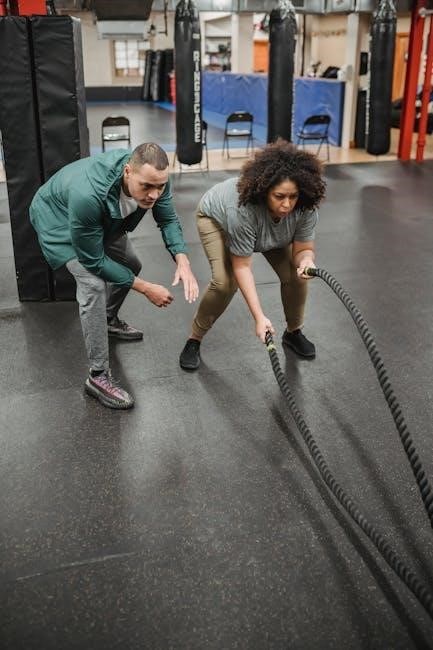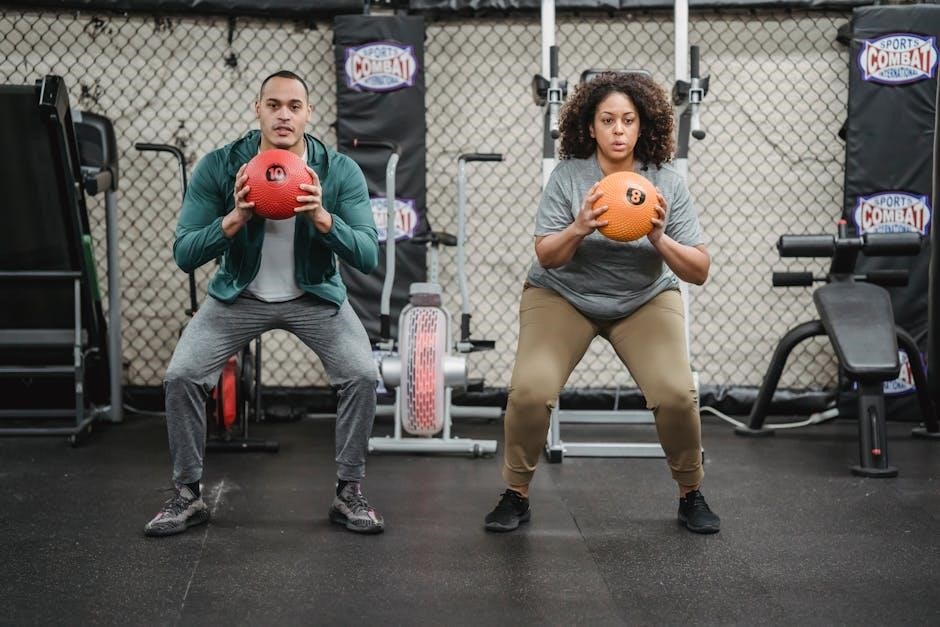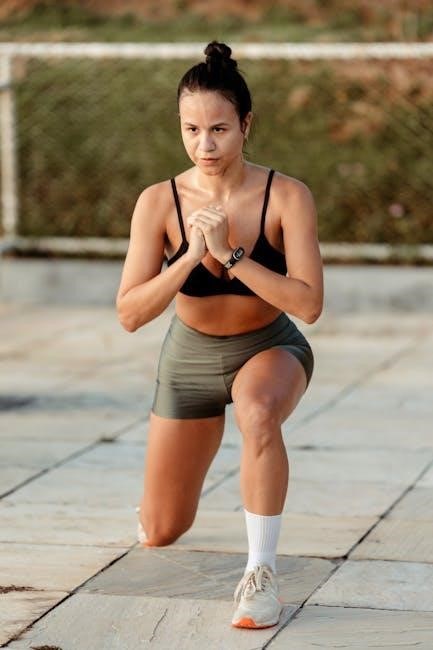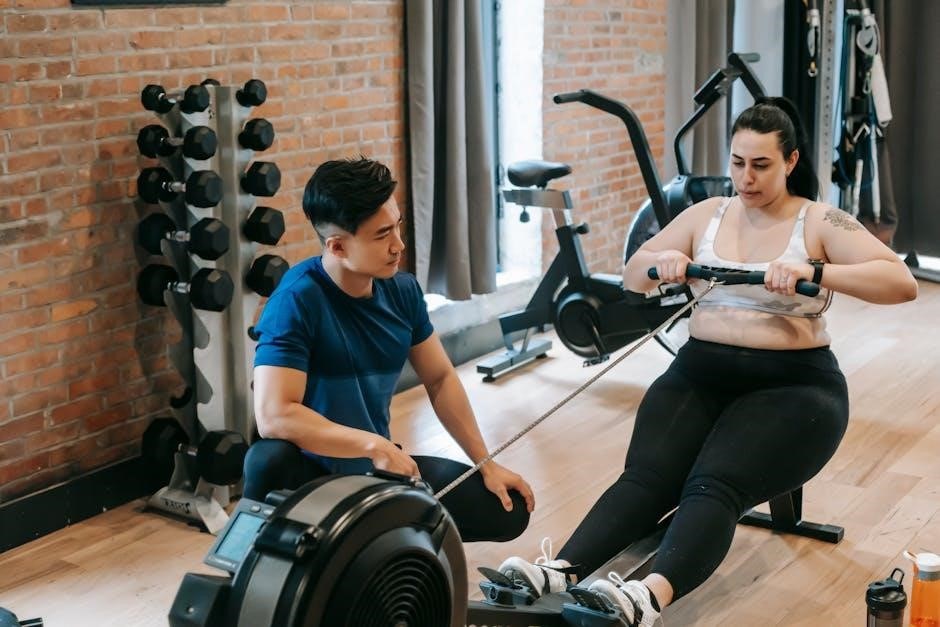
functional trainer exercises pdf
Functional trainer exercises are designed to enhance strength, mobility, and coordination using cable-based equipment. They focus on full-body workouts, improving daily movement patterns and overall fitness levels effectively.
1.1 What is a Functional Trainer?
A functional trainer is a versatile exercise machine using cables and pulleys to provide resistance. It allows for a wide range of movements, targeting multiple muscle groups simultaneously. Ideal for functional training, it enhances strength, mobility, and coordination, making it suitable for both rehabilitation and general fitness programs. Its adaptability makes it a popular choice for full-body workouts.
1.2 Benefits of Functional Training
Functional training improves strength, balance, and coordination, enhancing daily activities. It targets multiple muscle groups, boosting overall fitness and reducing injury risk. Its dynamic movements mimic real-life actions, making it practical for various goals, from rehabilitation to sports performance. This holistic approach ensures comprehensive physical development, promoting long-term health and functional abilities in everyday life and athletic pursuits.

Key Principles of Functional Training
Functional training emphasizes natural movement patterns, engages multiple muscles, and enhances coordination, preparing the body for real-life activities and improving overall physical efficiency and balance effectively.
2.1 Focus on Movement Patterns
Functional training emphasizes natural movement patterns like squatting, pushing, and pulling. These exercises mimic daily activities, enhancing coordination and strength. By targeting multi-planar movements, they improve mobility, balance, and overall functional fitness, reducing injury risk and boosting performance in real-life tasks and sports. This approach ensures workouts are efficient and purpose-driven, addressing the body’s functional needs effectively.
2.2 Engaging Multiple Muscle Groups
Functional trainer exercises are designed to engage multiple muscle groups simultaneously, enhancing overall strength and efficiency. By targeting compound movements, such as squats and lunges, these exercises improve coordination and balance while working several muscles at once. This holistic approach ensures comprehensive fitness, making workouts more effective and time-efficient for full-body conditioning and real-world functionality.
2.3 Improving Coordination and Balance
Functional trainer exercises excel at enhancing coordination and balance by incorporating dynamic movements that challenge stability. Activities like single-leg squats or cable rotations require precise control, improving overall body awareness. These exercises strengthen stabilizer muscles, reducing injury risk and boosting athletic performance, while promoting better posture and fluid movement in daily activities and sports.
Safety Guidelines for Functional Trainer Exercises
Always use proper form and adjust resistance to your fitness level. Start with lighter weights to ensure control, and avoid movements that cause discomfort or pain.
3.1 Proper Warm-Up Techniques
A dynamic warm-up is essential before functional trainer exercises. Start with light cardio like jogging or cycling for 5-10 minutes. Incorporate mobility drills such as arm circles, leg swings, and torso twists to prepare muscles and joints. Focus on major muscle groups to improve flexibility and reduce injury risk. End with muscle activation exercises to ensure readiness.
3.2 Using Equipment Safely
Always inspect functional trainer equipment for damage before use. Adjust cables and attachments to suit your height and movement range. Use proper form to avoid strain, and consider a spotter for added safety. Start with lighter resistance to test the setup, then gradually increase intensity. Follow manufacturer guidelines for equipment usage and maintenance to ensure a safe workout experience.

Functional Trainer Exercises for the Lower Body
Functional trainer exercises target the lower body through cable-based movements, improving strength, mobility, and stability. They include squats, lunges, and step-ups, enhancing overall leg and hip function effectively.
4.1 Squats and Variations
Squats are a cornerstone of lower body functional training, targeting quadriceps, hamstrings, and glutes. Variations like bodyweight, goblet, and cable squats enhance strength and mobility. These exercises improve functional movement patterns, boosting stability and power for daily activities and sports. Incorporating resistance or plyometric elements can further challenge muscle groups, promoting overall lower body development and athletic performance effectively.
4.2 Lunges and Step-Ups
Lunges and step-ups are excellent for targeting the lower body, focusing on legs, glutes, and core stability. They improve balance, coordination, and functional movement patterns. Variations like walking lunges or elevated step-ups add challenge. These exercises enhance unilateral strength, reducing muscle imbalances and boosting performance in daily activities and sports. Incorporating resistance, such as cables, further intensifies the workout, promoting overall lower body development and athletic function.
Functional Trainer Exercises for the Upper Body
Functional trainer exercises for the upper body focus on building strength and endurance in the chest, shoulders, and triceps. They include chest presses, lateral raises, and rowing movements. These exercises improve multi-planar strength, enhancing daily activities and sports performance. Variations like incline presses and cable rotations target specific muscle groups for balanced development.
5.1 Push-Ups and Pressing Movements
Push-ups and pressing movements are foundational exercises for upper body strength. Functional trainers allow for cable-based presses, targeting chest, shoulders, and triceps. Incline presses and chest presses enhance muscle engagement. These movements improve pushing power, essential for sports and daily activities. Variations like single-arm presses and rotational movements add complexity, promoting balanced development and functional strength.
5.2 Pull-Ups and Rowing Exercises
Pull-ups and rowing exercises target the back, arms, and shoulders, enhancing lat strength and overall pulling power. Functional trainers offer cable-based variations like assisted pull-ups and seated rows. These exercises improve posture, reduce injury risk, and build a strong upper body. They are versatile for both beginners and advanced trainees, promoting functional strength and endurance for daily activities and sports performance.

Core-Strengthening Functional Trainer Exercises
Core-strengthening exercises improve stability, balance, and overall trunk strength. Functional trainers enable effective workouts like planks, rotations, and dynamic movements, enhancing posture and reducing injury risks.
6.1 Planks and Stabilization Exercises
Planks are foundational core exercises that strengthen the abdominals, obliques, and lower back. Using a functional trainer, planks can be modified with resistance to enhance stability and endurance. Dynamic variations, like cable-assisted plank rows, engage multiple muscle groups for improved functional strength. These exercises promote better posture, reduce injury risk, and enhance overall core stability for daily movements and sports performance.
6.2 Dynamic Core Movements
Dynamic core movements target the entire core musculature through active, movement-based exercises. Using a functional trainer, exercises like rotational torso twists and cable crunches enhance flexibility and strength. These dynamic exercises improve coordination, stability, and power, making them essential for athletes and individuals seeking functional fitness for daily activities and sports performance.
Creating a Functional Training Routine
Creating a functional training routine involves setting clear goals, structuring workouts to target all muscle groups, and incorporating dynamic movements for overall fitness and mobility.
7.1 Setting Fitness Goals
Setting fitness goals is crucial for a structured functional training routine. Define clear, measurable objectives like improving strength, endurance, or mobility. Assess current fitness levels to create realistic targets. Break goals into short-term and long-term milestones to track progress effectively. Tailor exercises to align with these goals for maximum efficiency and motivation in your workout plan.
7.2 Structuring a Workout Plan
Structuring a functional trainer workout plan involves organizing exercises to target specific muscle groups and movement patterns. Begin with compound movements like squats and push presses, then progress to isolation exercises for detailed targeting. Incorporate a mix of lower body, upper body, and core exercises, ensuring a balanced routine that enhances strength, mobility, and coordination progressively.
Advanced Functional Training Techniques
Advanced functional training incorporates techniques like plyometrics and resistance progression to enhance power, speed, and overall performance, pushing individuals to new fitness levels.
8.1 Incorporating Plyometrics
Plyometric exercises, such as jump squats and box jumps, enhance power and explosiveness. These dynamic movements improve muscle reactivity and speed, making them ideal for advanced functional training routines. Incorporating plyometrics boosts athletic performance and overall agility, while challenging the body in new and engaging ways to achieve higher fitness levels effectively.
8.2 Adding Resistance and Progression
Increasing resistance and progression in functional training enhances strength and muscle endurance. Use adjustable cables, weights, or resistance bands to challenge muscles progressively. Gradually intensify workouts by adding load or complexity to movements, ensuring continuous improvement and avoiding plateaus. This approach keeps exercises engaging while promoting long-term physical development and functional fitness goals effectively.
Functional Trainer Equipment and Accessories
Essential equipment includes cable machines, pulleys, and interchangeable handles. Accessories like resistance bands, ankle straps, and grips enhance workout versatility and functionality, ensuring efficient training sessions.
9.1 Essential Equipment for Functional Training
Functional training requires versatile equipment like cable machines, pulleys, and adjustable handles. Resistance bands, kettlebells, and medicine balls are also key, providing dynamic resistance for strength and mobility exercises. These tools enable efficient full-body workouts, targeting multiple muscle groups and improving coordination. They are essential for achieving functional fitness goals effectively and safely.
9.2 Accessories for Enhanced Workouts
Accessories like mini bands, super bands, and blackrolls enhance functional training by improving mobility and adding resistance. Kettlebells and medicine balls are ideal for dynamic movements, while balance tools like wobble boards refine stability. These accessories diversify routines, boosting intensity and engagement. They support progressive overload and functional progression, ensuring workouts remain challenging and effective for all fitness levels.

Functional Training for Specific Sports
Functional training enhances athletic performance by tailoring exercises to specific sports demands, improving strength, agility, and endurance. It helps athletes master sport-specific movements and reduce injury risks effectively.
10.1 Training for Endurance Sports
Functional training for endurance sports focuses on building stamina and efficiency through dynamic movements. Exercises like high-intensity interval training and plyometric drills improve cardiovascular endurance and muscular stamina. These workouts simulate race conditions, helping athletes maintain performance over long durations while preventing fatigue and enhancing recovery. They are essential for sports requiring sustained energy output and resilience.
10.2 Functional Training for Team Sports
Functional training is ideal for team sports, enhancing agility, coordination, and explosive power; Exercises like lateral lunges, box jumps, and cable rotations mimic game-specific movements, improving reaction time and teamwork. This approach helps athletes develop the stamina and strength needed for high-intensity plays, ensuring peak performance during competitions while reducing injury risks.
By incorporating plyometrics and resistance bands, players can build functional strength tailored to their sport, whether it’s soccer, basketball, or rugby. These workouts focus on multi-directional movements, replicating real-game scenarios to boost overall athleticism and strategic execution on the field.
Functional Trainer Exercises for Rehabilitation
Functional trainer exercises are excellent for rehabilitation, improving mobility and strength through controlled movements. They use cables and resistance bands to restore muscle function and stability gradually.
11.1 Post-Injury Rehabilitation Exercises
Functional trainer exercises are ideal for post-injury rehabilitation, offering controlled resistance to restore strength and mobility. They help repair damaged muscles and joints through precise, low-impact movements.
Exercises like cable-assisted leg extensions or shoulder rotations promote gradual healing and stability, reducing the risk of re-injury while improving overall function and flexibility.
11.2 Improving Mobility and Flexibility
Functional trainer exercises enhance mobility and flexibility by targeting specific muscle groups through controlled, dynamic movements. Cable-based exercises, such as lateral pulls and leg swings, improve joint range of motion and reduce stiffness, promoting better posture and ease in daily activities.
Functional trainer exercises offer comprehensive fitness benefits, enhancing strength, mobility, and coordination. For further guidance, explore functional trainer exercise PDFs online, providing detailed workout plans and techniques.
12.1 Summary of Key Points
Functional trainer exercises enhance strength, mobility, and coordination using cable-based equipment. They improve daily movement patterns, reduce injury risk, and boost overall fitness. These exercises are adaptable for all fitness levels, focusing on practical, real-world applications. Utilizing functional trainer exercise PDFs provides structured workout plans, techniques, and progressions to achieve specific fitness goals effectively and safely.
12.2 Finding Functional Trainer Exercise PDFs Online
Functional trainer exercise PDFs are widely available online, offering detailed workout plans and techniques. Reputable websites, fitness forums, and platforms like Google Drive or Scribd provide accessible resources. Use search terms like “functional trainer workout” or “cable machine exercises” to find comprehensive guides tailored to specific fitness goals and skill levels.